The headline story of The Louisiana Weekly of 19 January 1946 was simple, “S. W. Green, Noted Fraternal Leader, Dies.” The Weekly remains our only source of information about the passing of this race leader who spent more than four decades in building a national fraternal insurance empire. The name S. W. Green means little to the vast majority of New Orleanians. Once one of his race’s most well-known leaders, both of the structures with which his life can be most associated have fallen into obscurity. Green was responsible for the first high-rise building constructed by and for African-Americans in the city of New Orleans. When the seven-story Pythian Temple at 234 Loyola Avenue was dedicated in the spring of 1908, S. W. Green was just assuming national control of the Colored Knights of Pythias, the national fraternal organization he would lead for twenty-seven years.
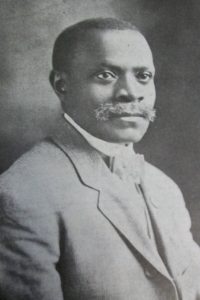
Smith Wendell Green (1860-1946) – Fifth Supreme Chancellor of the Knights of Pythias
Smith Wendell Green was born in the small Louisiana Delta town of Waterproof on 12 August 1861.1 Green was one of six known children born to James S. Green, a literate freedmen, and Serena Smith. All of the biographical sketches produced during his lifetime neglect mentioning anything about his early life or education, some just barely noting his birth in Tensas Parish. His brother Samuel J. Green, a noted educator, mentioned in some of the same sources, is listed with details of his education. Samuel Green was five years younger than his brother Smith, and thus would not have been born into slavery.
The few sources which exist agree upon the fact that his early education was under private tutelage and in the public schools of Tensas Parish. Whether he continued his studies, like his brother for example, who attended Knoxville College, is unknown. At a young age, Green embarked upon a career as a merchant and settled at Lake Providence in East Carroll Parish. He quickly rose to prominence among the black elite of northeastern Louisiana. On 21 April 1884, Green entered into a brief marriage with Eliza Hardin, of his native Waterproof, which produced one son, Smith Wendell Green, Jr. On 27 May 1890, Green married Lorania A. Crane, the stepdaughter of Jacques Adolph Gla, a Civil War veteran and Republican political leader. His new wife was also a sister-in-law of John W. Cooke, also a prominent Republican leader, who would become one of his closest friends and fellow Pythians.
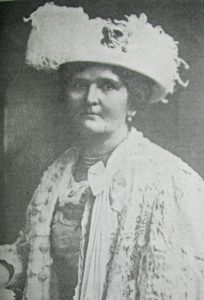
Mrs. Lorania Crane Green – Supreme Worthy Matron of the Order of Calanthe
While still actively engaged in his mercantile business, Green invested heavily in real estate in East Carroll Parish and northwestern Mississippi. By forging alliances with leaders such as those in his wife’s family and others in New Orleans, Green made a name in the political sphere as a committeeman for the Fifth District Republican Committee and as a delegate to the Republican National Conventions of 1896, 1908, 1912, 1916, and 1920. His only run for office came in 1890, when he lost the Fifth District race for United States Congress to white Democrat Charles Boatner by a margin of over 11,000 votes.
Following the Civil War, American men felt an increasing need for fraternal organizations, thus the Knights of Pythias of the World were formed in 1864. Within the African-American community, Prince Hall Masonry had spread like its nearly exclusively white counterparts since the 1790s. Two of the largest national fraternal orders, the Benevolent and Protective Order of the Elks and the Knights of Pythias, both denied membership to men of color. Due to the admission of several black Mississippians who were able to acquire Pythian secrets and rituals, the Knights of Pythias of North America, South America, Europe, Asia, Africa, and Australia were founded in Vicksburg in April 1880. During its earliest years, the Colored Knights of Pythias, often called “the alphabetical order,” to distinguish it from similar orders, spread quickly through the Mississippi Delta and Louisiana.
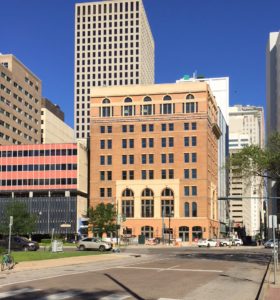
Pythian Temple, dedicated in 1909 (recently renovated and opened as market & apartments)
Green joined the Colored Knights of Pythias on 17 July 1883 when he became a charter member of Pride of Tensas Lodge No. 21 at St. Joseph, Louisiana. Having been instrumental in the lodge’s founding, he was immediately elected to the office of Vice Chancellor, but served as Chancellor Commander as the need arose until June 30, 1886. At that time, he was elected as the Grand Representative from his lodge to the Grand Lodge of Louisiana. Green’s abilities evidenced themselves and he was elected to several successively higher offices until he was elected Grand Chancellor in May 1892. He served in that position until 1897 and reacquired the office in 1899. It was the following year, when Green and his wife first made their residence in New Orleans. Always eager to enter another business venture, Green briefly owned a saloon at 154 Second Street. For a brief while, Green apparently also tried his hand in the printing business.
Upon reassuming the Grand Chancellorship, he found the finances of the Grand Lodge in disarray. By 1902, Green had pulled the Grand Lodge completely out of debt, with a small surplus on hand. Four years later that surplus had grown so that endowment payments (death benefits) for members were raised from $300.00 to $500.00. At the 1906 Grand Lodge Session in Alexandria, Louisiana, Green recommended that a Pythian Temple be erected in New Orleans. That session and subsequent sessions approved appropriations toward the construction of the Temple building. Under the chairmanship of S. W. Green, the impressive seven-story edifice, which in its day cost $200,000.00 dollars, was dedicated on 18 August 1909.
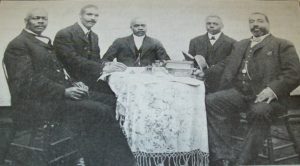
Pythian Temple Building Committee – Dr. H. H. Ford, John D. Brown, Smith W. Green, Frank B. Smith, John W. Cooke
At the Supreme Lodge at Pittsburg, Pennsylvania in 1905, he was elected to the position of Supreme Vice Chancellor and ex-officio Supreme Worthy Counselor. At the Supreme Lodge session in Louisville, Kentucky in 1907, he was re-elected to that position and held it until 3 April 1908, when he became Supreme Chancellor due to the death of the Samuel W. Starks of Charleston, West Virginia. Green would continue to hold the order’s highest office by popular election from 1909 to 1935.
During his tenure of nearly thirty years as international head of the Colored Pythian Order, Green oversaw the construction of the Pythian Bathhouse and Sanitarium at Hot Springs, Arkansas in 1914, and the construction of the Pythian National Temple in Chicago in 1928 at a cost of over $1,400,000.00.13 Within his own adopted city of New Orleans, Green oversaw the construction of the imposing seven-story Pythian Temple at Loyola and Gravier streets. The New Orleans Temple like its larger counterpart in Chicago, not only provided a home for Pythian meetings and offices, but also rented space to African-American merchants and insurance companies. The New Orleans Temple included a large theater in which several men saw a show which inspired the costuming of the famed Zulu Social Aid and Pleasure Club. The building’s elegant roof garden was a popular site for jazz performances and for years hosted the prom of McDonogh No. 35 High School, the city’s first black public high school.
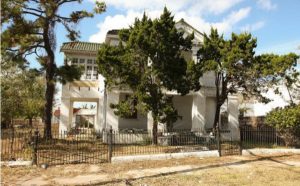
S. W. Green Residence – 219 South Miro Street, New Orleans
Perhaps conscientiously, Green had his own palatial residence at 219 North Miro Street constructed in 1928, the year that the Pythian National Temple in Chicago was dedicated. To African-Americans around the country, these two buildings, both built under the watch of a man born into slavery, were triumphant symbols of what knowledge and hard work could attain. Green’s success as evidenced by his fine home would have been well-known to blacks across the city. Nearly every major civic meeting or public effort within the African-American community from the turn-of-the-century until World War II included the name of S. W. Green among its promoters and supporters. Green lost his bid for reelection as Supreme Chancellor by one vote, due to the late arrival or absence of many of his staunch supporters. The Pythians of his home state again elected him their Grand Chancellor, a position he held until death. By 1941, Green sold his Liberty Industrial Life Insurance Company to the Universal Life Insurance Company. Retiring from active life, Green spent his last years in the mansion he had built with the company of his wife of fifty-six years. Green spent the Christmas Holiday of 1945 with his nephew, Dr. Wendell Philipp Green and relatives in Chicago. After returning to New Orleans, Smith Wendell Green, Past Supreme Chancellor of the Colored Knights of Pythias died on the evening of 10 January 1946. After simple obsequies in the chapel of the Blandin Funeral Parlor, Green was laid to rest in Saint Louis Cemetery No. 3 on Esplanade Avenue.
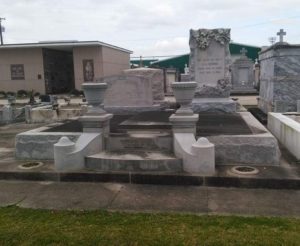
S. W. Green Grave – Saint Louis Cemetery No. 3
Among his friends in the clergy who eulogized him in glowing oratory, was Bishop Robert Elijah Jones, first African-American bishop of the Methodist Episcopal Church. Bishop Jones’ words, which moved those gathered to tears, summed up Green’s life work tremendously: “… Countless Negroes owe him a real debt of gratitude. He came along at a time when Negroes knew little about business and demonstrated what could be achieved through collective effort.” S. W. Green was but one African American leader who was able to both benefit from and benefit others through the rise of fraternal and benevolent societies.
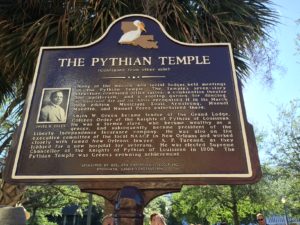
Marker just across from the Pythian Temple, recently erected by the Plessy & Ferguson Foundation
Jari Honora
Sources: Smith Wendell Green, Death Certificate (Orleans Parish), Volume 222-Page 239 (1946), Louisiana State Archives; J. S. Green household, 1880 Federal Census, Tensas Parish, Louisiana; “The Negro in Louisiana: Seventy-Eight Years of Progress,” (New Orleans: Sepia Socialite Publishing Company, 1942), 146; Tensas Parish Marriage Book, Clerk of Court’s Office, St. Joseph; East Carroll Parish Marriage Book, Clerk of Court’s Office, Lake Providence; David M. Fahey, “Colored Knights of Pythias,” in Nina Mjagkij, ed., Organizing Black America (New York: Garland Publishing, 2001), 167-68; S. W. Green, Joseph L. Jones, E. A. Williams, History and Manual of the Colored Knights of Pythias, N.A., S.A., E.A., A. and A. (Nashville: National Baptist Publishing, 1917), 906-08; Soards’ New Orleans City Directory for 1901 and 1906; “Grand Chancellor Laid to Rest with Simple Rites Here,” The Louisiana Weekly, 19 January 1946, page 1.



Another Outstanding piece of history by Jari C.Honora.
Thank you for the wonderful information.
Thank you for your in depth history on Mr. Green and his incomparable contribution to the City of New Orleans. I am blessed and fortunate to have been the last resident at his palatial home on 219 South Miro up until August 29th 2005. The home was a beacon of light, hope and shelter for the neighbors of that beautiful home. We stayed on the stairwell during the hurricane, praying and clinging to each other. I will forever be grateful to have been the caretaker and last resident of that majestic home. Let Perpetual light shine on Mr. Green.
I am so happy to learn about this, and this remarkable man! I was wondering about the Pythian Temple bldg. recently restored and opened as a market place-apartments on Loyola, just yesterday! Oh, Jari, thank you for another wonderful story of true history that should never be forgotten!
Please feel free to SHARE this on my facebook page! More people need to know about this great man, and the many others who fought for justice and care for the less fortunate!
Great writing. One underlying theme tells why so many Blacks were Republicans and how horrible what has happened to the Republican Party belies the Republican Party’s history and beginnings.
Excellent article thanks for sharing it. I would have never known.
Thanks for sharing information about this remarkable man. My grandparents met at the Pythian Temple in the roof garden. My mother, who is 95 years old, remembers her parents’ stories about the dances there.
I look forward to the wonderful history and hope the millennials are taking note. The research fills in many areas of history that I had questions about. Thanks.
The article on S.W. Green is excellent. The photographs are well-chosen, and the listed resources will help future researchers. Jari Honora–you did a great job!
My family is from Waterproof! This is a very interesting read. Thank you!
Great knowledge and insightful.I am a member of almost forgotten Fraternal order known as The Knight of Pythias of NA,SA,Africa,Asia, Europe and Australia.I am proud of Sir Knight S.W.Green.
Great job. Jari please call me at 843-861-5689.
Sadly, the Smith Wendell Green mansion was moved from its original location to Banks Street due to the construction of the massive Medical Center. I drove past it a while back, and it appears to be in danger
Can you tell me the address on Banks St. to where the Green mansion was moved? Thanks!
The S. W. Green Mansion is at the downriver, lakeside corner of Banks and S. Rocheblave streets.
Thank you!
I am a Pythian Knight in the NY Domain , I look up to you, Sir.